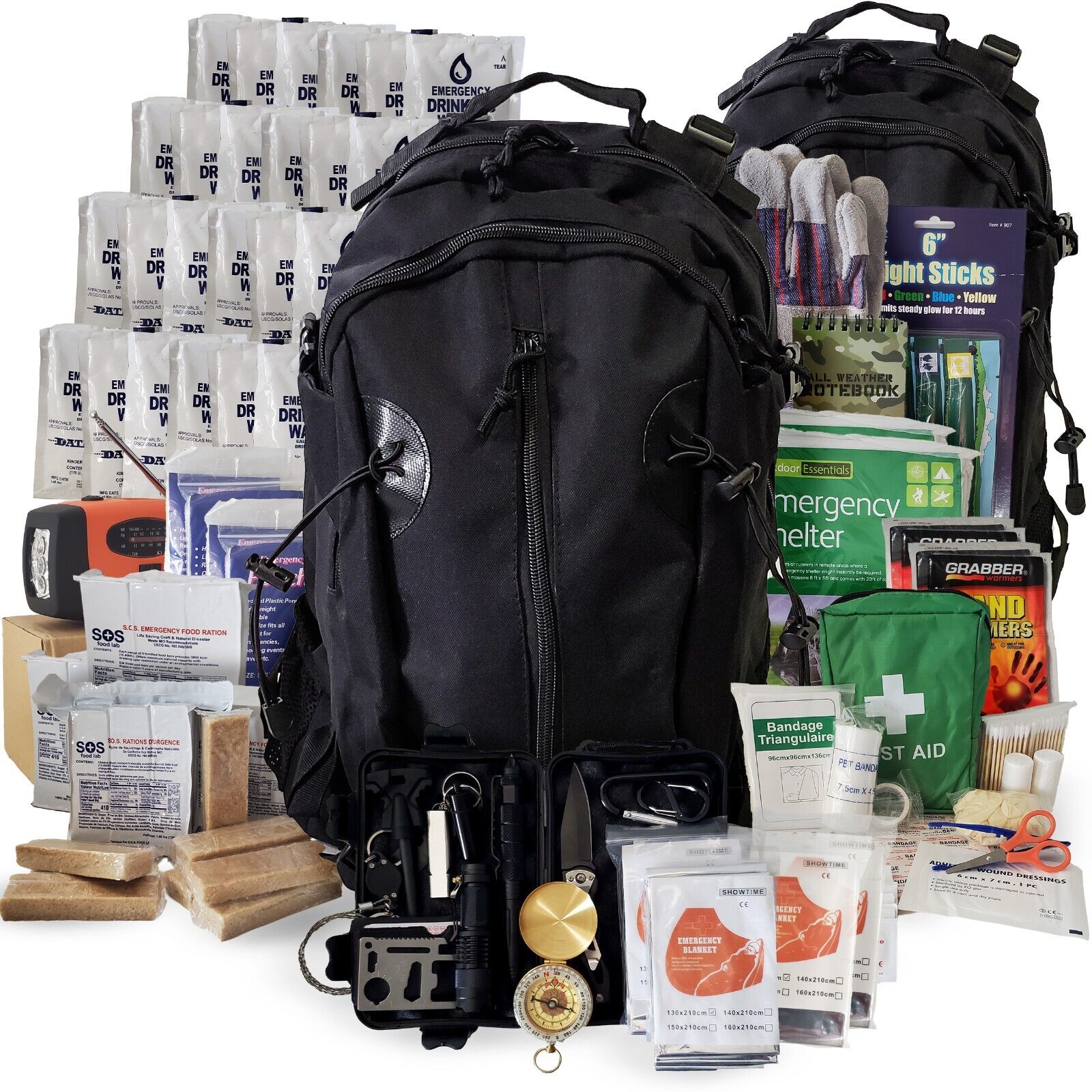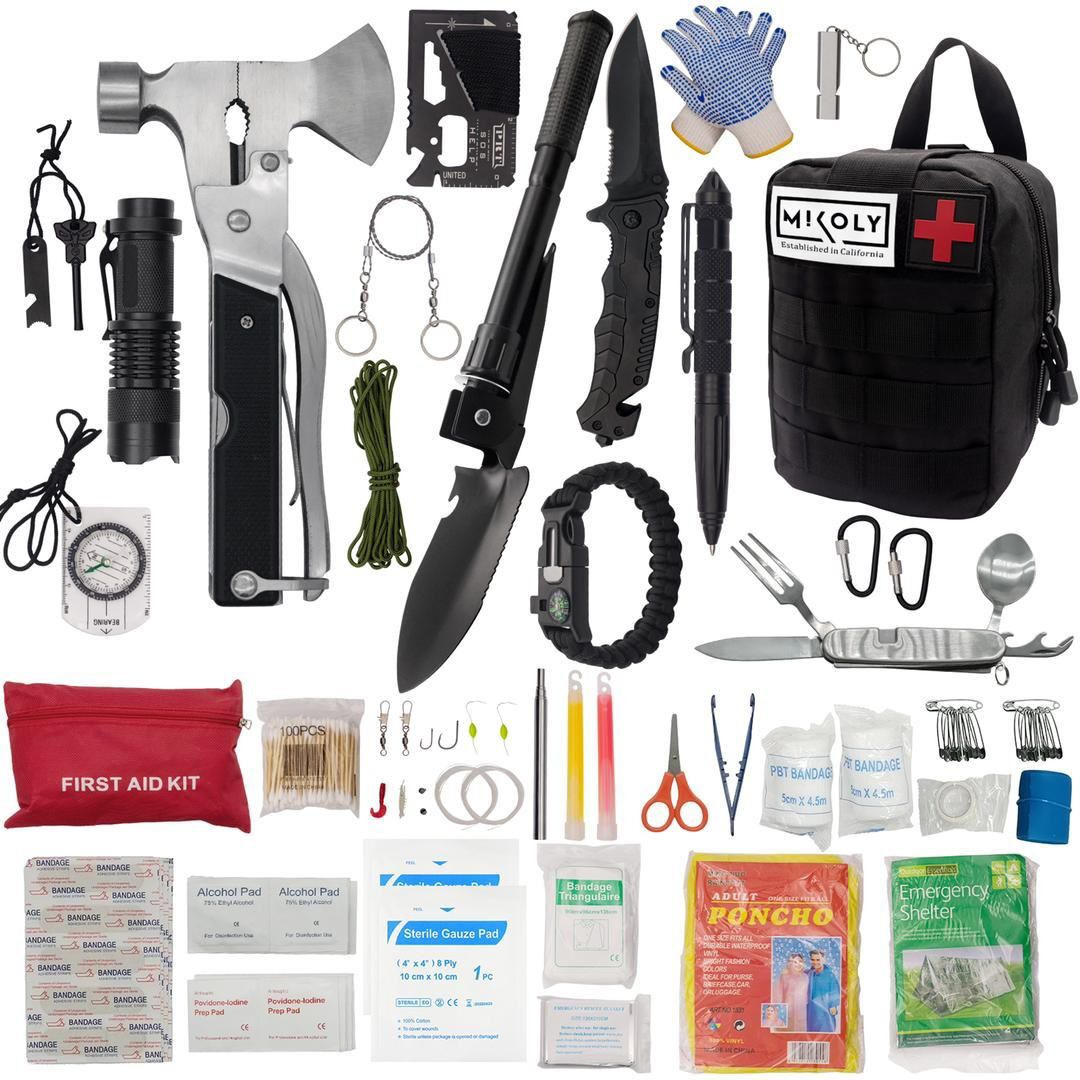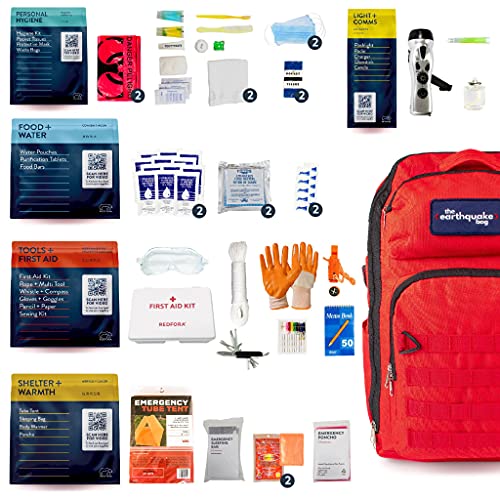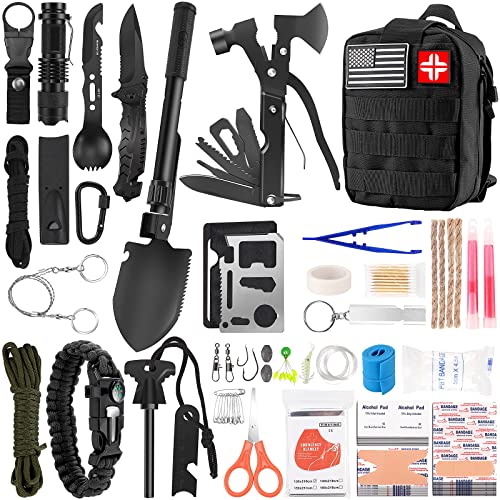As tensions between global superpowers like the USA, Russia, China, and Iran continue to escalate, the threat of a nuclear attack - once a distant fear - is becoming an increasingly realistic possibility. The devastating power of nuclear weapons, coupled with the lingering effects of nuclear fallout, presents a grim outlook for those caught in the crossfire. But even in the face of such overwhelming odds, survival is not only possible but achievable with the right knowledge, preparation, and gear. This comprehensive guide will delve into the concept of nuclear war, thermonuclear war, the reality of nuclear fallout, and the essential steps for ensuring survival in these dire scenarios.
A nuclear explosion can not only result from warfare, but also terrorism, or accidents at nuclear facilities. The primary dangers include:
- Immediate blast effects: Destruction and casualties in the immediate vicinity.
- Thermal radiation: Causes fires and severe burns over a larger area.
- Nuclear fallout: Radioactive particles lifted into the atmosphere by the blast that eventually fall back to earth, posing health risks.
Check Out This YouTube Video Of The Russia 1961 Tsar Bomb Hydrogen Blast
Understanding Nuclear War
Nuclear war, a military conflict where nuclear weapons are deployed by one or more parties, harnesses the power of nuclear reactions to unleash devastating blasts, capable of causing widespread destruction and loss of life. The threat posed by nuclear weapons is twofold: the immediate effects of the blast and the long-term impacts of nuclear fallout.
The Devastating Power of Nuclear Weapons
A nuclear weapon's destructive power is derived from the energy released during nuclear fission or fusion reactions. This energy manifests as a massive explosion, capable of obliterating entire cities. The blast's intensity is measured in kilotons or megatons of TNT, with a single megaton being equivalent to one million tons of TNT. To put this into perspective, the atomic bomb dropped on Hiroshima during World War II had an estimated yield of around 15 kilotons.
The Lingering Threat of Nuclear Fallout
The immediate blast is only one aspect of a nuclear weapon's threat. Equally worrisome is the nuclear fallout, referring to the radioactive particles that are propelled into the atmosphere following a nuclear explosion. These particles, which can include elements such as cesium-137, cobalt-60, and strontium-90, can spread over vast areas, contaminating the air, soil, and water, leading to radiation exposure.
Exposure to nuclear fallout can result in acute radiation syndrome, causing symptoms such as nausea, vomiting, hair loss, and skin burns. Prolonged exposure can lead to long-term health problems, including various forms of cancer, underscoring the critical nature of radiation exposure awareness.
Preparing for Survival
In the face of a nuclear threat, preparation is key to survival. This encompasses a wide range of measures, from securing adequate shelter to stocking up on essential survival gear and food supplies, forming a comprehensive nuclear survival kit. Be as prepared as possible when you get the Nuclear warning.
1. Educate Yourself and Your Family
- Understand the signs of a nuclear threat and the recommended actions from local authorities.
2. Prepare an Emergency Kit
- Water: At least one gallon per person per day for at least two weeks.
- Food: Non-perishable, easy-to-prepare items for at least two weeks.
- Medications: A supply of prescription and over-the-counter medications.
- Radio: Battery-powered or hand-crank radio to stay informed.
- Other Essentials: Flashlights, batteries, first aid supplies, and personal hygiene items.
3. Plan for Evacuation and Shelter
- Identify potential shelters in your home and community.
- Make an evacuation plan that includes multiple routes and meeting points.
Securing Shelter
The first step towards surviving a nuclear fallout is to find a suitable shelter. In the event of a nuclear blast, you would ideally want to be in a reinforced concrete or brick structure with a basement. The goal is to put as much material and distance as possible between you and the outside world, where fallout particles can settle, creating an expedient shelter.
Stocking Up on Essential Supplies
Having the right supplies on hand is crucial for survival in a nuclear fallout. This includes a sufficient stockpile of food and water, medical supplies, and radiation detection devices. It's also important to have a reliable source of power, such as batteries or a generator, and communication devices to stay informed about the situation outside, all part of a well-prepared nuclear survival kit.
When it comes to food and water, the key is to have supplies that are sealed and free from contamination. Canned goods, packaged meals, and bottled water are ideal. It's also worth considering survival food kits, which are specifically designed for emergency situations, ensuring non-perishable food and water purification measures are in place.
Survival Gear
In addition to food and water, there are several pieces of survival gear that can greatly enhance your chances of surviving a nuclear fallout. These include nuclear survival gear like radiation shielding garments, Geiger counters, and emergency medical kits, all essential components of a comprehensive survival strategy.
- Radiation detectors Devices like Geiger counters and the Kearny fallout meter are invaluable for monitoring radiation levels in your immediate surroundings. They empower you with the knowledge to make informed decisions about when it's safe to venture outside, helping to minimize radiation exposure effectively.
- Protective clothing Specialized protective clothing, including hazmat suits, offers a layer of defense against radioactive particles, thanks to advanced radiation shielding and radiation-blocking materials.
- First aid kits Equipping yourself with a well-stocked first aid kit, an indispensable piece of survival gear, can be a game-changer, especially when medical assistance is out of reach, embodying the essence of preventive medicine practices.
- Survival tools Essential tools for any survival situation include a multi-tool, flashlight, and a reliable supply of batteries, highlighting the critical nature of survival gear, the versatility of multipurpose tools, and the undeniable utility of flashlights.
Planning for Evacuation
Sheltering in place is initially advised following a nuclear blast, but there might be circumstances when evacuation becomes imperative. Whether it's due to worsening conditions in your fallout shelter or directives from civil defense authorities, being ready to evacuate and navigate through a contaminated landscape is a pivotal aspect of survival planning.
Evacuation plans should outline a safe destination, ideally far from the nuclear fallout zone, and include a well-thought-out route that considers potential obstacles, as part of thorough crisis preparation.
 During a Nuclear Warning: Taking Action
During a Nuclear Warning: Taking Action
1. Seek Shelter Immediately
- Indoors: Choose a basement or a central area without windows. The goal is to put as much material and distance between you and the fallout outside.
- Fallout Shelter: If you have a designated fallout shelter, ensure it's stocked and ready for use.
2. Stay Informed
- Use your radio to listen to official information and instructions.
3. Seal the Room (If Applicable)
- Close and seal all windows, doors, and ventilation to reduce infiltration of radioactive material.
Surviving the Immediate Aftermath
Surviving the initial aftermath of a nuclear fallout hinges on swift action and decisive thinking. Here's an overview of the immediate steps you should take following a nuclear blast, focusing on nuclear survival and essential survival skills.
Take Shelter
The first response following a nuclear blast should be to seek shelter. Preferably, this would be in reinforced concrete or brick structures with a basement. In the absence of such, any indoor shelter is preferable to outdoor exposure, emphasizing the critical role of a fallout shelter.
Protect Yourself
Once inside your shelter, it's crucial to take measures to shield yourself from fallout radiation. This involves staying away from windows and doors to prevent fallout particles from entering, and using a cloth to cover your mouth and nose, filtering out radioactive dust, thus minimizing radiation exposure and enhancing radiation shielding.
Stay Informed
Staying informed about the external situation is essential. A battery-powered or hand-crank radio becomes a vital communication tool, providing updates from emergency services and enabling informed decisions about the right time to exit your shelter, underscoring the importance of survival skills.
After a Nuclear Event: Staying Safe
1. Remain Sheltered
- Stay indoors and do not leave your shelter until authorities declare it safe to do so.
2. Avoid Contamination
- Change into clean clothes and shower if possible to remove fallout particles.
3. Check for Updates
- Continue to monitor official channels for updates on safety, assistance, and when it's safe to emerge.
Long-Term Survival Strategies
Surviving a nuclear fallout doesn't end with the initial blast and fallout. The long-term effects of such an incident, including ongoing challenges and dangers, necessitate continuous vigilance and survival preparations. Understanding the nuances of nuclear survival is crucial in these scenarios, highlighting the importance of being well-versed in nuclear survival strategies.
Dealing with Contaminated Food and Water
Securing safe food and water becomes a paramount challenge in a post-nuclear environment, as fallout particles can contaminate both. Having a reliable water purification method and knowledge of survival skills to decontaminate these essential resources is crucial, ensuring your ability to access clean water and safe food amidst the challenges.
Monitoring Radiation Levels
Even after the initial dangers subside, radiation levels can remain elevated for an extended period. Employing a Kearny fallout meter for regular monitoring is a practical step in managing radiation exposure and deciding when it's safe to venture outside, making it an essential tool for anyone serious about mitigating radiation exposure risks.
Ensuring Mental Well-Being
The journey of nuclear survival isn't solely about physical endurance; the mental and emotional toll is significant. Maintaining mental well-being through a routine, staying connected, and possibly seeking professional help are essential survival skills during such crises, underscoring the importance of holistic preparedness.
Conclusion
The feat of surviving nuclear fallout requires not just willpower but also thorough knowledge and preparation. By understanding the reality of nuclear fallout and engaging in proactive survival preparations, you can enhance your survival chances and secure your future against the unpredictable, making nuclear survival knowledge and nuclear fallout preparedness indispensable.
Therefore, arm yourself with the necessary nuclear survival gear, food, and knowledge. In the realm of nuclear survival, being the fittest and most prepared is key. Moreover, embracing prevention and diplomacy to avert nuclear conflict is the ultimate strategy for safeguarding against the unthinkable, ensuring you're equipped with the best nuclear survival gear and strategies.
4-Person Survival Backpack for 72 Hours
Be Prepared for Anything with Our 4-Person Survival Backpack
Product information
€187.24
Product Review Score
4.61 out of 5 stars
128 reviews
Product links
4-Person Survival Backpack for 72 Hours
Be Prepared for Anything with Our 4-Person Survival Backpack
Product information
€187.24
Product Review Score
4.61 out of 5 stars
128 reviewsProduct links
Essential Survival Items You Should Have
Survival situations can emerge unexpectedly, and being prepared can make a significant difference in outcomes. Whether you're gearing up for a wilderness adventure or preparing for potential emergencies, there are several essential items you should have on hand. Below, we'll detail some crucial survival items and why they're important.
Clothing and Personal Gear
- Good Boots: A sturdy pair of boots can be a lifesaver in rugged or hazardous terrain. They protect your feet from injury and provide the necessary support and grip for walking long distances.
- Gloves: Gloves protect your hands from cold, heat, and injuries while handling rough materials, making fires, or moving through dense vegetation.
- Face Masks: In scenarios involving dust, smoke, or potentially infectious diseases, face masks can protect your respiratory system from harmful particles.
Health and Safety
- Potassium Iodide: In the event of a nuclear accident or fallout, potassium iodide can help protect your thyroid from radiation poisoning by blocking radioactive iodine from being absorbed.
- Wipes: Hygiene is crucial for preventing infections, especially when clean water may not be readily available. Antiseptic wipes can be used for cleaning wounds or sanitizing hands.
Sustenance
- Water: Water is the most critical survival necessity. Always have a means to purify water, such as filtration systems or purification tablets, and if possible, carry a supply of clean water.
- Nuts and Dried Fruits: These are excellent sources of energy, vitamins, and minerals, all packed into lightweight, non-perishable packages. They provide the necessary calories and nutrition to maintain energy levels over extended periods.
Financial
- Cash: In situations where digital transactions are not possible due to power outages or network failures, having a supply of cash can be critical for purchasing essential goods and services.
Conclusion
Being prepared with these essential survival items can significantly enhance your resilience in various emergency situations. It's not just about having the items but also knowing how to use them effectively. Regularly review and update your survival kit to ensure that everything is in working order and that you're prepared for any situation that may arise.





